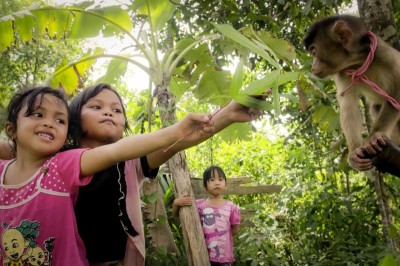
It is a shock to think of Indonesia as the world’s third largest emitter of greenhouse gases.
How could a country that boasts one of the world’s most diverse ecosystems be spewing out more carbon and methane than economic powerhouses such as Germany and Japan?
The answer lies in the forest. Or what’s left of it. Indonesia has cleared close to half of its forested land for agricultural development. The country’s peat forests, which sequester immense quantities of carbon are often targeted by developers, resulting in a disproportionate amount of emissions.
The village of Muara Tae and its indigenous population have come to represent the human impacts of this trend. Like so many other villages, they are facing displacement, or by some accounts extinction, to make space for a palm oil plantation.
“In 1993 it came my time to continue my parent’s tradition of guarding the forest” says Petrus Asuy, a Dayak leader who has organized against the expansion of the palm plantation. He and his group have enlisted the help of NGOs Telepak and the Environmental investigation Agency to push back the the bulldozers.

“What we want is simple: They have to be responsible by paying penance for the destruction of our habitat.”
In the US, Indonesian palm oil interests are looking for a new trade partner. The Renewable Fuel Standard, which was expanded in 2007, requires US gas to include an ever expanding amount of renewable fuels. Will the EPA stick by its original findings that the impact of land clearing makes palm based biodiesel not as green as some would like us to think, or bend to the pressure of lobbyists from the palm oil industry?


Great article and photos! Good questions for American lobbyists and the EPA. The film was terrific. How sad that Oil Companies feel compelled to continue to plow forrests which should be left intact along with the cultures and people that are dependent on this land,
Great story- sad subject.
Great photos and story.
Wow! What an amazing story! I’m horrified by how our best intentions create profound loss for others. Thank you for making the invisible visible.
Thanks for posting this informative story and video.
Around 90% of the global supply of palm oil comes from Indonesia and Malaysia, and this has come at a tremendous cost. The forests of Borneo and Sumatra are being burned to the ground– releasing tremendous amounts of greenhouse gases into the atmosphere. The UNEP estimates that the forests of Indonesia are being cleared at a rate of 6 football fields per minute every minute of every day.
The palm oil industry is guilty of the most heinous ecological atrocities imaginable, including the systematic genocide of orangutans. The forests of Borneo and Sumatra are the only place where these gentle, intelligent creatures live, and the cultivation of palm oil has directly led to the brutal deaths of thousands of individuals as the industry has expanded into previously undisturbed areas of rainforest.
When the forest is cleared, adult orangutans are typically shot on sight. These peaceful, sentient beings are beaten, burned, mutilated, tortured and often eaten. Babies are torn off their dying mothers so they can be sold on the black market as illegal pets to wealthy families who see them as status symbols of their own power and prestige. This has been documented time and again.
If nothing is done to protect orangutans, they will be extinct in just a few years. Visit the Orangutan Outreach website to learn more: http://www.redapes.org
Orangutan Outreach
Reach out and save the orangutans!
I have been to Borneo and seen the destruction first hand. One step to solution is for a consumer boycott of palm oil. To follow this all out pressure on Unilever and all the other major food and cosmetic companies that use non-sustainable palm oil in their products: everything from candy to lipstick.
Great article and good video branden.. I have never seen this type videos. Well the Indonesian agricultural sector and various government initiatives are expected to help it grow and boost its production. As per the agricultural industry reports Indonesia, the export figures in 2013 for the palm oil sector would give the country a chance to answer questions being raised regarding its potential as an ago-based country.